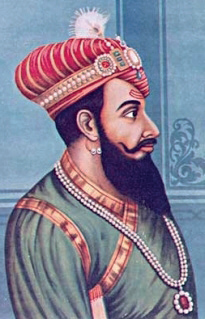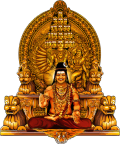The Lineage of Regent Kings
Lineage of Regent Kings
The region around present day Thanjavur was ruled by the Mutharayars who were landlords and controlled the lands. Their primary occupation was agriculture and trade. They ruled in sixth century, up to 849.
Chola Empire
The Cholas came to prominence once more through the rise of the Medieval Chola monarch Vijayalaya (841–878) in about 850. Vijayalaya conquered Thanjavur from the Mutharayar king Elango Mutharayar and built a temple dedicated to the Hindu Goddess Nisumbhasudani. His son Aditya I (871–901) consolidated the hold over the city. Gradually, Thanjavur became the most important city in the Chola Empire and remained its capital till the emergence of Gangaikonda Cholapuram in about 1025.
The Chola king Raja Raja Chola I (985–1014)
| During the first decade of the eleventh century, the Chola king Raja Raja Chola I (985–1014) constructed the Brihadeeswarar Temple at Thanjavur. The temple is considered to be one of the best specimens of Tamil architecture. |
When the Chola Empire began to decline in the 13th century, the Pandyas from the south emerged as the rulers in Thanjavur from 1279 to 1311.
Invasions in Thanjavur
Mughal Invasion
1311-1335
The kingdom of Thanjavur was raided by the forces of the Mughal general Malik Kafur (1296–1306) and later annexed by the Delhi Sultanate.
The Sultanate extended its authority directly over the conquered regions from 1311 to 1335.
Mughal Invasion
1311-1335
The Islamic forces of Malik Kafur raised the Kingdom of Thanjavur which was again annexed by the Delhi Sultanate. This marked the end of the Chola Dynasty in Thanjavur, and the denizens of the kingdom were robbed of their own glorious history
Mughal Invasion
1311-1335
The kingdom of Thanjavur was raided by the forces of the Mughal general Malik Kafur (1296–1306) and later annexed by the Delhi Sultanate. “
The Sultanate extended its authority directly over the conquered regions from 1311 to 1335
and then through the semi-independent Ma’bar Sultanate from 1335 to 1378.
1674
The Rajput King Ekoji I, half brother of Chatrapati Shivaji of the Bhonsle Dynasty, conquered Thanjavur and safeguarded the kingdom from further Islamic invasion
Nayak Dynasty
1674
Achuthappa Nayak (1560–1614), Raghunatha Nayak (1600–34) and Vijaya Raghava Nayak (1634–73) are some of the important rulers of the Nayak dynasty who ruled Thanjavur. Thanjavur Nayaks were notable for their patronage of literature and arts.
Then, the Madurai Nayak King Chokkanatha Nayak (1662–82) took over and ruled in 1673. Vijaya Raghunatha Nayak, the son of Chokkanatha, was killed in a battle and Chokkanatha’s brother Alagiri Nayak (1673–75) was crowned as the ruler of the empire.
British Occupation
The kingdom was absorbed into British India because the lack a legitimate male heir after the death of Shivaji II.
This was a strategy used often by the British to annex native kingdoms, using the “Doctrine of Lapse” as justification.
The British annexation of Thanjavur
The kingdom was eventually absorbed into British India in 1855 by the Doctrine of Lapse when Shivaji II (1832–55), the last Thanjavur Maratha ruler, died without a legitimate male heir. The British referred to the city as Tanjore in their records.[8] Five years after its annexation, the British replaced Negapatam (modern-day Nagapattinam) with Thanjavur as the seat of the district administration.
The Doctrine of Lapse
Maratha kings of Thanjavur retained sovereignty through the 17th and 18th century
• 1787 Serfoji became a minor Raja but the regent King deposed his throne
• 1799 In a twisted strategy, the British restored Serfoji to the throne but forced him to relinquish most of his administration of Thanjavur
• 1855 The British used the lack of a legitimate heir (“Doctrine of Lapse”) after Shivaji II to absorb the Kingdom of Thanjavur into British India.
Vijayanagar Kings
1135 – 1600
The kingdom was absorbed into British India because the lack a legitimate male heir after the death of Shivaji II.
This was a strategy used often by the British to annex native kingdoms, using the “Doctrine of Lapse” as justification.
Vijayanagar Dynasty
1350
The Vijayanagara Dynasty subdued the Sultanate influence over Thanjavur.
The Vijayanagara Kings
Following are four stone inscription evidences to show the Vijayanagara dominance over Thanjavur after the Cholas: The Vijayanagara King Krishna Deva Raya’s inscription dated 1443, Thirumala’s inscription dated 1455 and Achuta Deva’s land grants dated 1532 and 1539.
Mughal Invasion
1335 – 1378
Ma’bar Sultanate was a short lived independent kingdom based in the city of Madurai in Tamil Nadu, India. The sultanate was proclaimed in 1335 when the then viceroy of Madurai, Jalaluddin Ahsan Khan declared his independence from the Delhi Sultanate.
Ahsan Khan and his descendants ruled Madurai and surrounding territories until 1378.
The last sultan, Ala-ud-Din Sikandar Shah fell in battle against the forces of the Vijayanagara Empire led by Kumara Kampana. In this short reign of 43 years, the Sultanate had 8 different rulers.
The Maratha line of Thanjavur (“Tanjore”) kings ruled Thanjavur through the British Occupation.
Bhonsle dynasty
Thanjavur was successfully conquered in 1674 by Ekoji I (1675–84), the Maratha feudatory of the sultan of Bijapur and half-brother of Shivaji (1627/30-80) of the .
Ekoji founded the Thanjavur Maratha kingdom which ruled Thanjavur till 1855.[8][11]The Marathas exercised their sovereignty over Thanjavur throughout the last quarter of the 17th and the whole of the 18th century. The Maratha rulers patronized Carnatic music.
In 1787, Amar Singh, the regent of Thanjavur, deposed the minor Raja, his nephew Serfoji II(1787–93) and captured the throne.
Serfoji II was restored in 1799 with the assistance of the British, who induced him to relinquish the administration of the kingdom and left him in charge of Thanjavur fort and surrounding areas.


Rajput King Ekoji I
The region around present-day Thanjavur was ruled by the Mutharayars who were landlords and controlled the lands. Their primary occupation was agriculture and trade. They ruled in the sixth century, up to 849.
The Cholas came to prominence once more through the rise of the Medieval Chola monarch Vijayalaya (841–878) in about 850. Vijayalaya conquered Thanjavur from the Mutharayar king Elango Mutharayar and built a temple dedicated to the Hindu Goddess Nisumbhasudani.
His son Aditya I (871–901) consolidated the hold over the city. Gradually, Thanjavur became the most important city in the Chola Empire and remained its capital till the emergence of Gangaikonda Cholapuram in about 1025.
During the first decade of the eleventh century, the Chola king Raja Raja Chola I (985–1014) constructed the Brihadeeswarar Temple at Thanjavur. The temple is considered to be one of the best specimens of Tamil architecture.
When the Chola Empire began to decline in the 13th century, the Pandyas from the south emerged as the rulers in Thanjavur from 1279 to 1311.
The Mughal invasion of Thanjavur
The kingdom of Thanjavur was raided by the forces of the Mughal general Malik Kafur (1296–1306) and later annexed by the Delhi Sultanate. The Sultanate extended its authority directly over the conquered regions from 1311 to 1335 and then through the semi-independent Ma’bar Sultanate from 1335 to 1378. Malabar Sultanate was a short-lived independent kingdom based in the city of Madurai in Tamil Nadu, India. The sultanate was proclaimed in 1335 when the then viceroy of Madurai, Jalaluddin Ahsan Khan declared his independence from the Delhi Sultanate. Ahsan Khan and his descendants ruled Madurai and surrounding territories until 1378.
The last sultan, Ala-ud-Din Sikandar Shah fell in battle against the forces of the Vijayanagara Empire led by Kumara Kampana. In this short reign of 43 years, the Sultanate had 8 different rulers.
The Vijayanagara Kings
Following are four stone inscriptions evidence to show the Vijayanagara dominance over Thanjavur after the Cholas: The Vijayanagara King Krishna Deva Raya’s inscription dated 1443, Thirumala’s inscription dated 1455, and Achuta Deva’s land grants dated 1532 and 1539.
Sevappa Nayak (1532–80), the Vijayanagar viceroy of Arcot, established himself as an independent monarch in 1532 (1549, according to some sources) and founded the Thanjavur Nayak kingdom.
Achuthappa Nayak (1560–1614), Raghunatha Nayak (1600–34), and Vijaya Raghava Nayak (1634–73) are some of the important rulers of the Nayak dynasty who ruled Thanjavur. Thanjavur Nayaks were notable for their patronage of literature and arts.
Then, the Madurai Nayak King Chokkanatha Nayak (1662–82) took over and ruled in 1673. Vijaya Raghunatha Nayak, the son of Chokkanatha, was killed in a battle and Chokkanatha’s brother Alagiri Nayak (1673–75) was crowned as the ruler of the empire.
Thanjavur was successfully conquered in 1674 by Ekoji I (1675–84), the Maratha feudatory of the sultan of Bijapur and half-brother of Shivaji (1627/30-80) of the Bhonsle dynasty. Ekoji founded the Thanjavur Maratha kingdom which ruled Thanjavur till 1855. The Marathas exercised their sovereignty over Thanjavur throughout the last quarter of the 17th and the whole of the 18th century. The Maratha rulers patronized Carnatic music. In 1787, Amar Singh, the regent of Thanjavur, deposed the minor Raja, his nephew Serfoji II(1787–93), and captured the throne. Serfoji II was restored in 1799 with the assistance of the British, who induced him to relinquish the administration of the kingdom and left him in charge of the Thanjavur fort and surrounding areas.
The British annexation of Thanjavur
The kingdom was eventually absorbed into British India in 1855 by the Doctrine of Lapse when Shivaji II (1832–55), the last Thanjavur Maratha ruler, died without a legitimate male heir. The British referred to the city as Tanjore in their records. Five years after its annexation, the British replaced Negapatam (modern-day Nagapattinam) with Thanjavur as the seat of the district administration.

